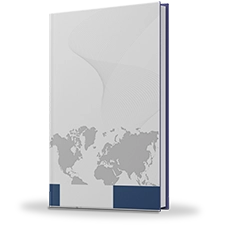Water Quality Instrument Market Research: 2032
The Global Water Quality Instrument Market Size was valued at $4.4 billion in 2022, and is projected to reach $7.4 billion by 2032, growing at a CAGR of 5.5% from 2023 to 2032.A water quality instrument system is a fully developed device that monitors various water quality indicators. It is recognized as a reliable analytic system for improving water quality. Regular water testing is essential for protecting water bodies from harmful pollutants. Monitoring water quality is useful for keeping track of factors such as temperature, nitrates, phosphates, macroinvertebrates, pH, oxygen, and others.
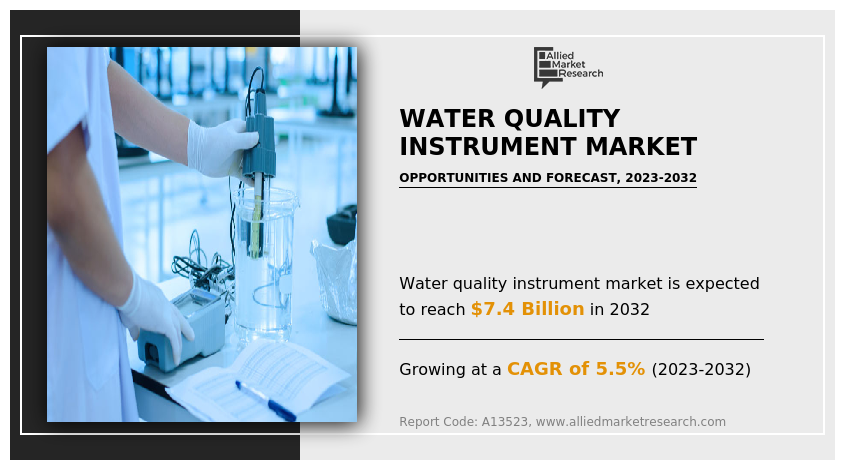
Market Dynamics
One of the main factors driving the water quality sensor market growth is government regulations or initiatives aimed at monitoring, testing, and surveillance of drinking water quality. This increase can be attributed to causes such as increase in industrial waste releasing in waterbodies, an increase in cases of drinking water contamination levels, major industrial pollution dangers, and rural community dependence on contaminated water sources. Water quality sensors are gaining significance due to the enforcement of strict laws, guidelines, and regulations by various government organizations. These regulations mandate regular evaluation, testing, and surveillance of drinking water quality, industrial wastewater treatment, and the use of spectroscopic techniques.
The increasing emphasis on addressing these issues has led to an increase in the importance of water quality sensors. For instance, in March 2021, an Indian Government Ministry named Jal Shakti launched guidelines and a framework for testing and monitoring the quality of drinking water. The guidelines, which were created with the help of the Indian Council of Medical Research, defined the work to be done in terms of monitoring and surveillance of water quality at the state, block/tehsil, and village levels. Total dissolved solids, pH value, total alkalinity, chloride, turbidity, chloride, iron, total coliform bacteria, fluoride, sulphate, and nitrate were the recommended water quality criteria under this guideline, catering to the market expansion of water quality instrument.
The water quality instrument market growth is projected to be hampered due to its high manufacturing costs. The incorporation of cutting-edge features and precision components contributes significantly to higher production expenses, hindering market expansion. Manufacturers are challenged to balance affordability with technological sophistication. This cost constraint affects market accessibility for various end-users, particularly in regions with budgetary limitations. Discovering a balance between innovation and cost-effectiveness becomes necessary for sustained growth. Industry players must navigate this challenge to ensure the widespread adoption of water quality instruments, enabling environmental sustainability and regulatory compliance.
The water quality instrument market is experiencing significant expansion, driven by the rising water pollution resulting from rapid industrialization and the discharge of toxic metal effluents and hazardous substances. The production of diverse industrial facilities has led to the generation of substantial amounts of untreated toxic waste, which is often released into nearby water bodies. This unregulated disposal has adverse effects on rivers, oceans, and other water ecosystems, leading to pollution and detrimentally impacting aquatic habitats and human health.
To address these challenges, there is a growing need for regular and controlled monitoring of water bodies using water quality sensors. These sensors play a crucial role in measuring various parameters such as total organic carbon, chlorine, arsenic, and others, helping to minimize the risks of water-borne diseases and skin ailments. Recent testing by the Central Water Commission, conducted between August 2018 and December 2020, revealed alarming levels of pollution, total coliform, and biochemical oxygen demand in water samples from 239 and 88 stations across 21 states.
This indicates poor wastewater treatment from industrial, agricultural, and domestic sources. In the foreseeable future, the demand for these sensors is expected to rise as they play a crucial role in mitigating the environmental and health impacts associated with inadequate water quality management. These factors are projected to create several growth opportunities in the water quality instrument market forecast period.
The key players profiled in this report include Hanna Instruments, Honeywell International Inc, Mettler Toledo, Xylem, Inc., Evoqua Water Technologies LLC, Heron Instruments Inc, Jenco Instruments Inc, Sea-Bird Scientific, HORIBA Group, and LaMotte Company. Investment and agreement are common strategies followed by major market players. For instance, in August 2021, HORIBA formed a partnership with Covalent Metrology, a leading North American company of analytical services. This partnership aimed to expand engineering and scientific access to world-class expertise and chemical analysis instruments.
The water quality instrument market is segmented on the basis of product type, test type, end user, and region. By product type, the market is divided into portable and bench-top. By test type, the market is classified into turbidity, pH, dissolved oxygen, conductivity, TOC, and others. By end user, the market is classified into water treatment plants, laboratories, industrial, aquaculture, and others. By region, the market is analyzed across North America, Europe, Asia-Pacific, and LAMEA.
The water quality instrument market is segmented into Product Type, Test Type and End User.
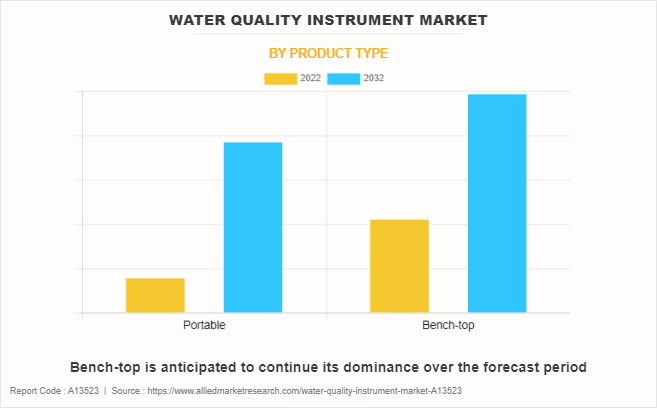
By Product Type,
The bench-top sub-segment dominated the market in 2022. The bench-top segment is a key driver in the water quality instrument market, driven by growing demand for accurate and efficient water testing in laboratory settings. Bench-top instruments offer precise measurements, user-friendly interfaces, and advanced analytical capabilities, catering to the stringent requirements of research, environmental monitoring, and industrial applications. The emphasis on water safety and regulatory compliance further boosts the adoption of bench-top water quality instruments, as they provide reliable data for assessing contaminants and ensuring water purity. In addition, technological advancements, such as automated features and connectivity options, enhance the overall appeal of bench-top instruments, contributing to their prominence in the market. These are predicted to be the major factors driving the water quality instrument market during the forecast period.
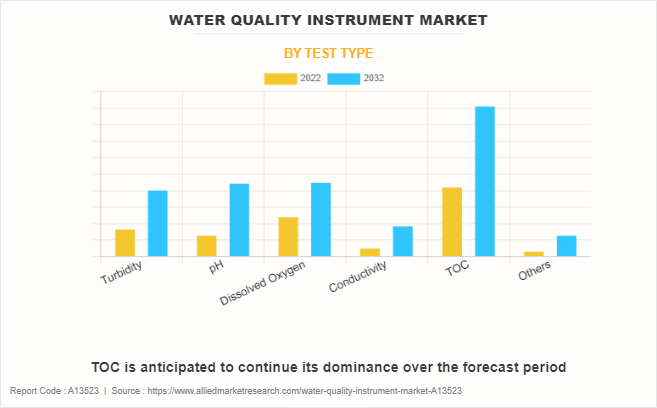
By Test Type,
The TOC sub-segment dominated the global water quality instrument market share in 2022. The water quality instrument market is driven by the growing emphasis on environmental monitoring. Stringent regulations and increasing awareness about water contamination drive the demand for advanced testing instruments. Rising demand for testing wastewater and municipal water for organic matter drives the development of Total Organic Carbon (TOC) analysis. TOC monitoring is a much faster way of detecting the organic matter content of water and wastewater. A TOC analyzer is often used for verifying water quality in the semiconductor and pharmaceutical sectors, and it also plays an essential role in the wastewater companies. These factors are expected to drive revenue growth of the segment during the forecast period.
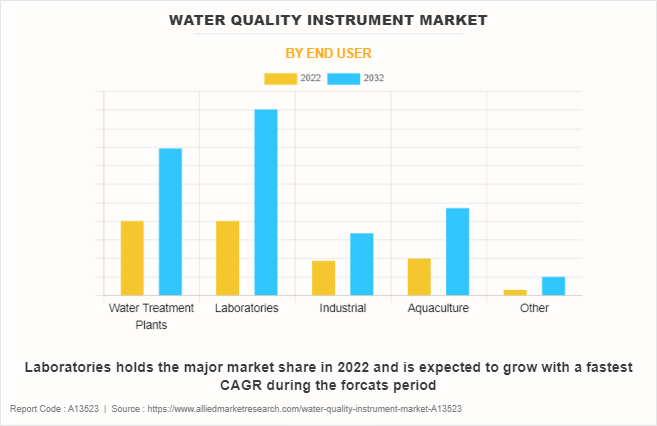
By End User,
The laboratories sub-segment dominated the global water quality instrument market share in 2022.The laboratory segment is a key driving force in the water quality instrument market, driven by stringent regulatory standards and the increasing need for accurate and reliable water analysis. Laboratories play a pivotal role in monitoring and ensuring water quality, driving demand for sophisticated instruments. Stringent testing requirements for contaminants, pollutants, and emerging substances boost the significance of advanced laboratory equipment. In addition, growing awareness regarding the impact of water pollution on public health emphasizes the crucial role of laboratories in safeguarding water quality. Therefore, investments in cutting-edge water quality instruments within the laboratory segment are rising to meet these pressing environmental and regulatory challenges.
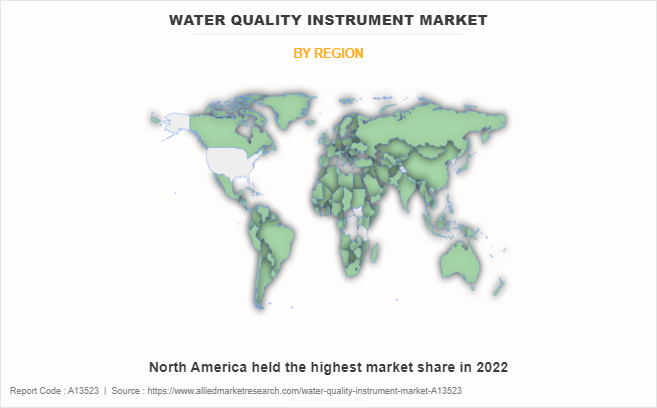
By Region,
North America dominated the global water quality instrument market in 2022. The factors driving the growth in the region are the growing initiatives and funding by the government regarding water pollution and contamination. The government has undertaken various initiatives, including the monitoring and reduction of chemical pollutants, the implementation of industrial wastewater treatment, and the control and reduction of urban and agricultural pollutants. These collaborative efforts by the government and various organizations to mitigate water contamination are anticipated to boost the demand for water quality monitoring products in the region. In addition, stringent measures imposed by regulatory bodies to address water contamination, such as setting targets to minimize leakage and imposing fines for non-compliance with regulations, are expected to drive the industry growth during the forecast period.
Impact of COVID-19 on the Global Water Quality Instrument Industry
- The global water quality instrument industry faced disruptions due to COVID-19, with supply chain challenges, workforce limitations, and project delays. However, increased awareness regarding water safety boosted demand for monitoring solutions, driving innovation and adaptation within the industry.
- Furthermore, various players in the market halted their production activities for several weeks to reduce the expenses. Whereas few players also had to lay-off employees to sustain during the COVID-19 health crisis.
- The COVID-19 pandemic also led to an increase in awareness among people regarding the importance of safety of consumable products, thus being a positive factor for the growth of water quality instruments market.
Key Benefits For Stakeholders
- This report provides a quantitative analysis of the market segments, current trends, estimations, and dynamics of the water quality instrument market analysis from 2022 to 2032 to identify the prevailing water quality instrument market opportunity.
- The market research is offered along with information related to key drivers, restraints, and opportunities.
- Porter's five forces analysis highlights the potency of buyers and suppliers to enable stakeholders make profit-oriented business decisions and strengthen their supplier-buyer network.
- In-depth analysis of the water quality instrument market segmentation assists to determine the prevailing market opportunities.
- Major countries in each region are mapped according to their revenue contribution to the global market.
- Market player positioning facilitates benchmarking and provides a clear understanding of the present position of the market players.
- The report includes the analysis of the regional as well as global water quality instrument market trends, key players, market segments, application areas, and market growth strategies.
Water Quality Instrument Market Report Highlights
| Aspects | Details |
| Market Size By 2032 | USD 7.4 billion |
| Growth Rate | CAGR of 5.5% |
| Forecast period | 2022 - 2032 |
| Report Pages | 300 |
| By Product Type |
|
| By Test Type |
|
| By End User |
|
| By Region |
|
| Key Market Players | Mettler Toledo, Heron Instruments Inc., Hanna Instruments, Evoqua Water Technologies LLC, Sea-Bird Scientific, LaMotte Company, Inc., Xylem, Inc., HORIBA Group, Honeywell International Inc., Jenco Instruments Inc |
The global water quality instrument market is driven by increasing awareness regarding environmental concerns, stringent regulatory requirements, and a growing emphasis on water safety. The rising demand for advanced monitoring and testing technologies, particularly in industrial and municipal applications is expected to create growth opportunities in the market. Innovations in sensor technologies, rising water quality standards, and investments in water infrastructure contribute to market growth. In addition, the adoption of smart water quality monitoring solutions presents a promising possibility for industry development.
The major growth strategies adopted by water quality instrument market players are investment and agreement.
Asia-Pacific is projected to provide more business opportunities for the global water quality instrument market in the future.
Hanna Instruments, Honeywell International Inc, Mettler Toledo, Xylem, Inc., and Evoqua Water Technologies LLC are the major players in the water quality instrument market.
The bench-top sub-segment of the product type acquired the maximum share of the global water quality instrument market in 2022.
Water treatment plants and laboratories are the major customers in the global water quality instrument market.
The report provides an extensive qualitative and quantitative analysis of the current trends and future estimations of the global water quality instrument market from 2022 to 2032 to determine the prevailing opportunities.
The water quality instrument market is expected to be influenced by trends such as the increasing adoption of smart sensors and IoT for real-time monitoring, a growing focus on water sustainability, and advancements in portable and user-friendly testing technologies, catering to both industrial and consumer needs.
Loading Table Of Content...
Loading Research Methodology...
